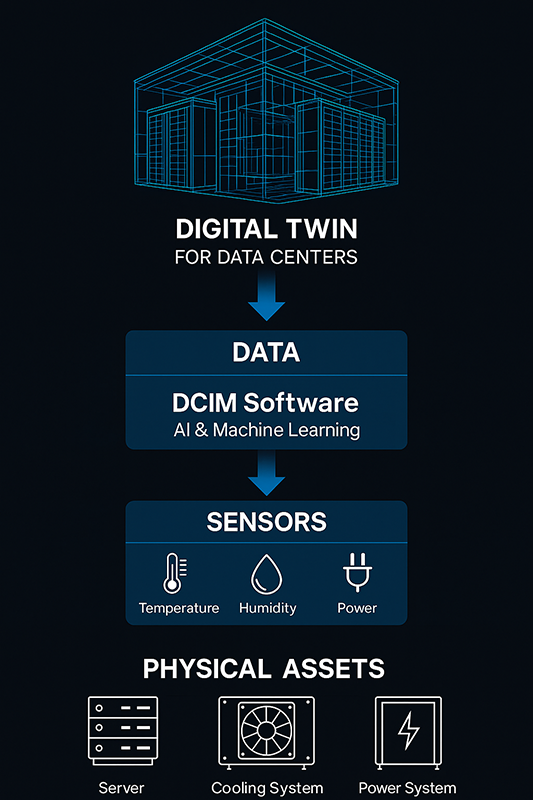Digital Twins In Data Center
The concept of a digital twin has evolved rapidly in recent years. It has become an essential tool for improving operational efficiency, capacity planning, and sustainability in modern data centers. A digital twin is a virtual replica of a physical entity. It is continually updated with real-time data, which allows organizations to simulate, predict, and optimize performance without impacting live operations. In the context of data centers, digital twins are revolutionizing how facilities are managed, maintained, and developed for future needs.
According to a 2025 industry report, the global digital twin market is projected to grow from USD 24.48 billion to USD 259.32 billion by 2032, exhibiting a CAGR of 40.1%. This explosive growth highlights the increasing adoption of digital twin technologies across multiple industries, including data centers.
How Digital Twins Benefit Data Centers
A digital twin of a data center enables operators to simulate the effects of various changes before they are made in the real environment. This can include evaluating cooling system modifications, power distribution layouts, and server placement strategies. Operators can visualize the airflow, monitor thermal hotspots, optimize rack layouts, and predict energy consumption, all within a simulated environment.
By proactively addressing potential issues through simulation, facilities can achieve greater uptime, enhanced energy efficiency, and improved asset utilization. Recent advances also enable modeling power usage at the chip level, allowing for even finer control over energy consumption and cooling strategies. This not only maximizes operational efficiency but also supports broader sustainability initiatives.
In fact, research suggests that implementing digital twin technology can reduce a building’s carbon emissions by up to 50%. For data centers, which are among the largest consumers of electricity globally, this impact is highly significant. It offers a critical pathway toward achieving ESG (Environmental, Social, and Governance) targets.

Integration with AKCP Monitoring Solutions
At AKCP, we recognize the critical role that real-time data plays in making a digital twin truly effective. Our environmental, power, and security monitoring systems form the foundation for a reliable digital twin model. Data collected from temperature sensors, thermal maps, humidity monitors, and power usage meters is streamed into DCIM (Data Center Infrastructure Management) platforms where the digital twin is maintained.
This continuous synchronization between the physical data center and its digital counterpart ensures accuracy and enables real-time decision-making. With AKCP’s comprehensive monitoring solutions, data centers can visualize thermal gradients, optimize cooling strategies, and model different operating scenarios for improved energy efficiency and resilience.
Real-World Applications and Case Studies
The application of digital twins in data centers is no longer theoretical. Real-world deployments demonstrate tangible benefits. For instance, Schneider Electric and ETAP, leveraging NVIDIA’s Omniverse platform, recently unveiled a digital twin that simulates AI factory power requirements from grid to chip level. This approach enhances predictive maintenance, optimizes grid usage, and streamlines energy consumption planning—principles directly transferable to the management of high-density, high-efficiency data centers.
Similarly, hyperscale data center operators are utilizing digital twins to model construction workflows, streamline maintenance schedules, and predict equipment failures before they occur. These predictive capabilities are powered by the integration of artificial intelligence (AI) into the digital twin framework, enhancing accuracy and reducing operational risk.
Sustainability and the Future of Data Center Operations
Sustainability is now a top priority for the data center industry. Digital twins contribute significantly to achieving green objectives by enabling smarter energy management and reducing carbon footprints. By analyzing real-time data in a virtual environment, operators can identify inefficiencies, test low-energy configurations, and balance loads more intelligently across the facility.
Moreover, digital twins support initiatives such as free cooling utilization, renewable energy integration, and predictive capacity management, all of which contribute to more sustainable, cost-effective operations.
As data centers continue to scale to meet the demands of cloud computing, AI, and IoT, the role of digital twins will expand further. Future developments will likely see even tighter integration with machine learning algorithms, allowing autonomous optimization of facility operations based on real-time and historical performance data.

Conclusion
Digital twins are no longer a futuristic concept; they are a present-day reality that is transforming data center operations worldwide. From improving energy efficiency and enhancing sustainability to enabling predictive maintenance and capacity planning, digital twins offer an unprecedented level of insight and control.
At AKCP, we are proud to provide the essential monitoring solutions that make effective digital twin implementations possible. By integrating real-time data with advanced modeling and simulation tools, data centers can realize the full potential of their physical and digital infrastructure—building smarter, greener, and more resilient operations for the future.
